What is Project Management?
What is Project Management?
Project managers are in high demand. Learn what they do and more.
Trusted by more than 10,000 teams worldwide
Start for freeEighty-three percent1 of organizations report that they can’t find qualified project managers to fill open positions.
While this is bad news for employers, it’s great news for job seekers and those looking to increase their salaries.
In fact, project managers make an average salary of $73,7452 and certified project managers make even more.
Nearly 22 million new project management positions will have been created between 2017 and 2027, with the industry forecasted to grow by 33 percent.3 If you have the right skills, you will be primed to take advantage of outstanding opportunities for career growth.
Now is the perfect time to figure out whether or not project management is right for you.
If you’re interested in learning more about the job, keep reading. In this guide, you will get a comprehensive answer to the question “what is project management?’ and many more questions like it.
What is Project Management?
We’re all project managers at some points in our lives. Whether it’s a quick undertaking, like organizing the garage over the weekend, or a complex, drawn-out one, like developing a website by the end of the year, these are temporary endeavors that have a definitive time frame with specific goals and objectives in mind.
Projects, then, are just unique undertakings that have a definitive start and end date.
People often get project work confused with operations management or rather “business-as-usual.” Check out the chart below to understand the key differences.
Operations Management
- Ongoing operations that are repeated
- Team consistently works together
- Maintains the business
- Repeatable work
- Fixed annual budget
Project Management
- One-of-a-kind tasks have a completion date
- Team disbands once work is done
- Introduces change
- Unique work
- Custom budget based on required tasks and resources
Examples of projects4 include:
- Building a new website
- Opening or closing a business location
- Making changes to the business to comply with regulation
- Hosting an event
- Software development
- Engineering a new building
- Solving a business problem
- Introducing a new business process or cultural change to the organization
Project Management Roles
When talking about project management, we often hear about the project manager, but of course, she isn’t the only person working on the project. Here are the various roles involved in a project. Some of these roles overlap with an individual wearing multiple hats.

Project sponsor
The project sponsor is accountable for the outcome or business impact of the project. She is often a high-up manager, who has a project idea that would benefit her department or project team. You can think of the project sponsor as the customer of the project.
Project manager (PM)
The project manager is like the CEO of the project. They’re responsible for leading the project team, organizing project requirements, settings specific goals and tracking progress.

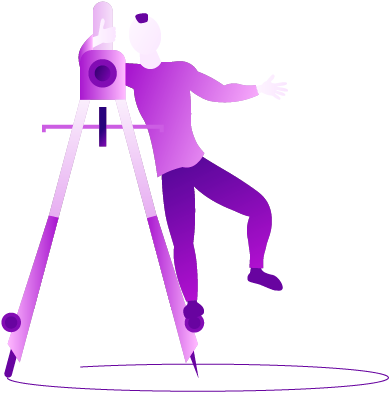
Supplier
Suppliers are the people or organizations doing the actual work. They can be an internal team, like the engineering team, or they can be external freelancers. Normally they are expected to deliver one or more portions of the project.
Team member
A team member is anyone tasked with completing a task of the project.

Stakeholder
A stakeholder is a person or group of people with a vested interest or “stake” in the project. They may be directly involved in the project or they may be affected by the project result. Typically, the PM updates stakeholders throughout the project lifecycle, looking for feedback on deliverables and performance while also managing their expectations.
Client
Clients are the people to whom the project is delivered.

Project Management in Practice
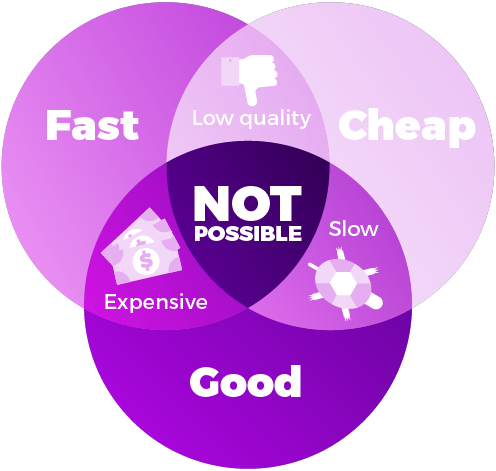
Now that you understand project management basics, let’s dive into how projects actually work.
Project Management Constraints
On any project, there will be competing constraints vying for the PM’s attention. It’s the PM’s job to juggle the needs of these constraints with with the desires of the project’s stakeholders and the overall goals of the project.
Triple Constraints
There are three primary constraints, known as the “triple constraints”.
Cost/Resources
This is the approved budget for the project or the business resources allocated to the project. It covers all the necessary expenses to deliver the project. A good PM makes sure not to overspend but also not to underspend. Many projects have a “use it or lose it” clause, which means you must spend everything in an allotted period of time or lose the remaining balance.Scope/Quality
Whatever the project is aiming to achieve is the project scope. The scope is the purpose or reason behind the project. Quality refers to the standards and criteria that the project’s scope must meet for the result to perform effectively. The product must provide the expected functionality, solve the identified problem, and deliver the expected benefits and value.Schedule/Timing
A project has a start and an end date – a fixed time frame. The organization expects the project to complete on time and has forecast the benefit from the project completion to be available by a certain date. Often these completion dates are tied to external milestones or events that cannot move. Some of the project activities can be conducted in parallel, but some must be done sequentially. The project manager and team must determine the best timing and sequence to complete the project. This will be outlined in the project management plan and will often involve the use of a Gantt chart.Additional Constraints
Risk
What could potentially go wrong if certain external events occurred? These are your risks. How likely is the event to occur? And what’s the impact it could have on the project? If the probability is too high, you should be proactive and create a plan to manage the risk.Compliance
The conduct of some projects is governed by government, industry, or organizational regulations and procedures. These procedures limit the options available to the project manager and project team. Deviations from these procedures can have dire consequences with regulatory bodies.Communication
Unless you are doing that small project for yourself, such as cleaning the garage, there will be other team members, suppliers, stakeholders, and clients involved. The more people and organizations involved, the more difficult it is to maintain clear directions and manage expectations. This becomes exponentially more difficult when there are project team members who are located in multiple locations or who speak different languages.All constraints are dependent on each other
Let’s pretend that a key stakeholder wants to add functionality to the website your team is responsible for building. This functionality is outside the original scope of the project, which most likely means, you’ll need more time and resources to do it.
On the other hand, if your project budget was cut, you’ll most likely need to remove items from the original scope. Which means you need to communicate the new project plan, change expectations, and examine the risks that are added by deleting work.
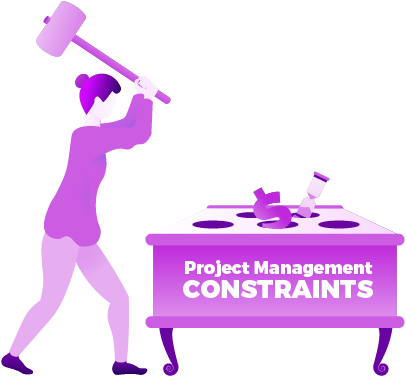
In short, constraints are all dependent on each other. It’s like that game you played when you were little – Whac-a-mole. Every time you pop a mole back in, another mole pops out of another hole.
Project Management Lifecycle
All projects undergo a series of phases – four phases, to be exact. These are also commonly referred to as project management steps.
1. Initiation Phase
The initiation stage of a project consists of getting the entire project group together – the team, its stakeholders, and other relevant parties to define the project’s goals and objectives, schedule constraints, and project management processes, such as how to communicate and procedures to follow. This is also the phase when the PM will draw up a project charter.
2. Planning Phase
Next, the work needs to be broken down into digestible chunks or deliverables with approximate timelines to complete each chunk. This can be visualized in a Gantt chart, which is the most commonly used chart for schedule purposes in project management. It can be used for project planning, but it’s best suited for tracking progress on a project.
Your Gantt chart will represent the order of tasks and how they are interdependent, which will provide you with a roadmap of the work through project completion.
3. Execution Phase
Once you have a roadmap, you can execute on it. The execution phase is when all of the work gets done. During this phase, you’ll monitor all of the work to ensure your project stays on track in terms of all your constraints, which we discussed above. When needed, you will create workarounds to resolve problems.
4. Closing Phase
After everything is complete, you’ll want to do a proper project post-mortem to understand what you achieved, and document and pass along useful learnings to the right teams.
This handy project close out checklist covers exactly what needs to be done at this point of the project.
During this phase, key stakeholders will approve the project and deliverables will be handed off to the clients and stakeholders.
Project Management Processes
Processes facilitate your project through its lifecycle until the project deliverables and outcomes are complete. Here’s a few of the most common project management processes.
Scope Management
The project scope is the sum of all the work that must be done on the project. Scope management is focused on defining and controlling what must be done on the project and what does not need to be done.
Scope management processes are used throughout the project lifecycle. As soon as the project charter is set, the PM will begin to manage the project scope. The final steps of the project are to turn over the product, service, or result of the project to the customer or stakeholders. In short, it is to deliver the scope.
Schedule Management
Schedule management (or time management) is the process of creating, maintaining and communicating schedules for time and resources. And they’re used throughout most of the project lifecycle.
Schedule management usually takes an iterative (or agile) approach because, in most projects, the schedule is frequently updated or changed, and it helps ensure the project is delivered on time with the correct features.
Schedule management processes closely interact with each other and many of the other project management processes. Project time management (schedule) is one of the three triple constraints on a project – the others being scope and budget (or resources).
Budget Management
Budget management (or cost management) refers to managing and controlling project costs.
Or to be precise, “Project Cost Management includes the processes involved in planning, estimating, budgeting, financing, funding, managing, and controlling costs so that the project can be completed within the approved budget.”
Cost management is closely coupled with a company’s financial accounting system, and is often tailored to be compatible with such a system.
This process is used throughout most of the project lifecycle.
In some organizations, the financial accounting system requires that all cost management activities be conducted by a selected department or group. In those cases, the project costs management activities may be done by individuals who are not part of the project team.
Team Management
“Project Team Management includes the processes that organize, manage, and lead the project team.”
The team management (or the human resources management) processes guide the entire project team, including the core team members, extended team and any other project team members.
Many of these processes must be used frequently throughout the project lifecycle.
Team members change, roles change and outside factors can influence internal team performance and relationships. If there are people involved (and there are always people involved) these processes apply.
These processes are focused upon the project team and team issues. The team may be a small, intimate team, or it may be a large multi-cultural team who have never met in-person before.
In either case, team management processes should be used, but the amount of time and effort to achieve the process outputs and the number of tools and techniques needed may change dramatically.
In some cases, the project team, or a portion of it, may report directly to the project manager. In most cases though, they don’t, and when this is the case, the value of these processes is increased.
Although it should go without saying, ethical behavior is essential to maintain effectiveness with your project team. If they ever think you’re lying, stealing or cheating, it’s virtually impossible to ever regain their confidence.
Risk Management
Risk management processes guide the project manager and project team in the identification, analysis, response and control of risk.
While risk management should be practiced throughout the time frame of the project, the emphasis has a tendency to change. Early in the project there are many risks and uncertainties, but there are also many options for addressing those risks.
As the project progresses, the number of risks decreases because things that were uncertain become known. However, the ability to respond to risk and the magnitude of the risk impact increases because there is less time and resources left as you approach project completion.
Because of the unique nature of a project, there are uncertainties. There are things that have never been done a certain way, by this project team, to achieve the objectives for this project, in this time period and with these business conditions.
While a project manager normally manages the risk management process, they rely heavily on their project team members, who are often subject matter experts, to identify threats and opportunities.
Risk management is normally a standard part of every project team meeting. Because while it’s impossible to eliminate risk on a project, it can be managed.
Early in the project the emphasis needs to be on identifying all risks so that a project plan can be put in place that:
- Avoids threats
- Leverages opportunities
- Has risk response options built in for those threats that cannot be avoided
Before the project plan is baselined,5 risk responses should be included for all major threats. As the project progresses, the emphasis shifts to finding early warnings of new risks and checking the efficacy of the original risk response.
Sometimes, you’ll hear about “known” risks and “unknown” risks.
Known risks are those that we’ve identified as a threat or opportunity, but the likelihood of occurrence is uncertain.
Unknown risks are risks that have not yet been identified.
In some cases, a category of risk can be identified, but the specific risk won’t be known until the project progresses. Examples include: weather delays on a construction project or software bugs on an IT project.
Communication Management
“Project Communication Management includes the processes that are required to ensure timely and appropriate planning, collection, creation, distribution, storage, retrieval, management, control, monitoring and the ultimate disposition of project information.”
Communication is at the heart of project management. Virtually everything a project manager does involves communication. In today’s world, there are a million ways to communicate online.
The project manager should use whatever technologies are commonly found among members of the project team and stakeholder community.
Project managers must be skilled at written and oral communication, formal presentations and informal discussions with all levels of the organization.
On some projects, the project manager will also need to be skilled at communicating with the public and press. One of the best core competencies a project manager can develop is good communication skills.
Stakeholder Management
“Project stakeholder management includes the processes required to identify the people, groups, or organizations that could impact or be impacted by the project, to analyze stakeholder expectations and their impact on the project, and to develop appropriate management strategies for effectively engaging stakeholders in project decisions and execution.”
Project stakeholder management is concerned with communicating with project stakeholders in order to understand and meet their needs.
Stakeholders are engaged with the project from the very first day until the very last. Different stakeholders will take on a more important role at various stages of the project lifecycle.
Customers, or senior management, will initially approve or authorize the project, commencing the project management processes.
Customers, or users, will receive the final goal of the project near the end of the project and senior management should be involved with the lessons learned and project closeout activities.
Every project has stakeholders.
While stakeholders can be highly beneficial to a project, when they provide clarity and focus, and make rapid decisions, they can also create havoc, if they are disengaged, unclear and make conflicting decisions.
I have seen it go both ways.
The project manager needs to engage with all the key stakeholders, who influence the scope, resources and/or acceptance of the project. These key stakeholders must be well understood and their needs and concerns must be addressed as best they can while still keeping the project within its constraints. Doing so often requires strong interpersonal and communication skills.
Project Management Methodologies
A project management methodology is “a system of practices, techniques, procedures and rules used by those who work in a discipline.”
A methodology, or a project management system, helps those in the organization involved with projects to know what to expect. The definition of best practices and templates will normally speed up a project, and improve its overall quality.
A project management methodology is created by an organization to establish a pattern for a type of project. If your project fits that type, you should follow the pattern or methodology.
How to develop a project management methodology
To develop a methodology, consider industry best practices for the type of project you’re managing. Also, look to examples of that type of project that went well in your organization previously.
Don’t automatically adopt the best practices published in books or on blogs. You must use good judgement because there’s a culture that must accompany any methodology for it to be successful.
If your organization has a “hero-based” culture, don’t adopt a methodology that requires strict process discipline. If your culture is data-driven, rely on analytical project management approaches, not one that requires extensive team meetings and collaboration.
For a methodology to succeed, senior management must understand the methodology and how they are involved with projects.
Senior managers, who routinely direct the project teams to do things that violate the methodology, will ensure that it’s not followed. If senior management wants to change the methodology, change it.
It is better to have an imperfect methodology that is followed than no methodology at all.
Sequential (Waterfall)
One of the most prominent project management methodologies is the sequential (or waterfall) methodology.
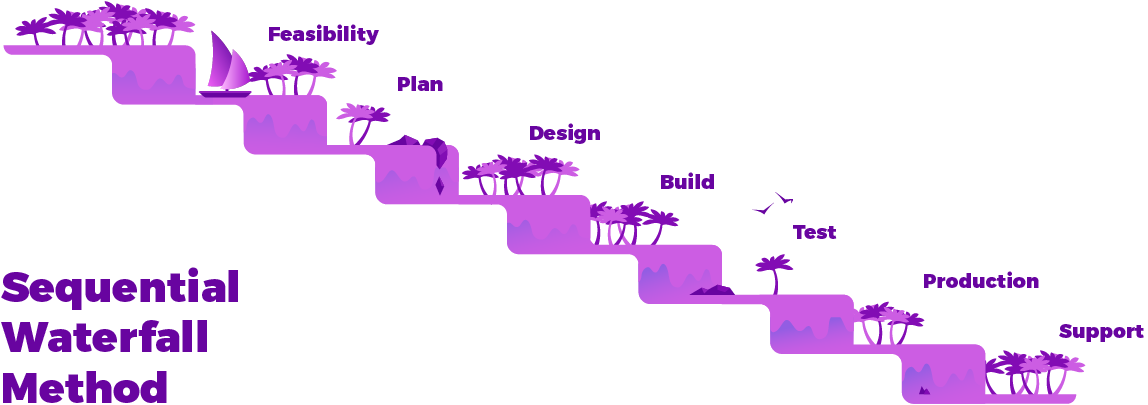
The waterfall model is a sequential (non-iterative) design process, in which progress is seen as flowing steadily downwards (like a waterfall) through the phases of conception, initiation, analysis, design, construction, testing, production/implementation and maintenance.
This means that team members can’t move onto the next step in the process until the step before it is complete. Because this process goes in a specific order, team members can’t go back to a previous step without starting from scratch, which means there’s no room for errors or changes.
The waterfall model allows no room for changes or errors; therefore, project managers must plan extensively in the beginning and then carefully follow the plan.
Waterfall Advantages
- Because the waterfall approach requires detailed record keeping, future projects can be improved.
- Everything is crystal clear to the client from the beginning. They know exactly what they’ll get and for how much.
- Thanks to waterfall’s strong documentation, you don’t have to worry about employee turnover ruining a project.
- Easier to manage.
Waterfall Disadvantages
- Team members can’t go back to a previous stage, once a phase has been completed.
- Because this methodology relies heavily on the initial requirements, if the requirements are bad in any respect, the project will fail.
- If a requirement error is detected or a change must happen, the project has to start from square one.
- The entire project isn’t tested until the very end.
- This method doesn’t take into account the evolving needs of the client. What if a client realizes they need more features than they initially thought? The project will be delivered late and it will increase the budget.
- Takes longer.
When should you use the waterfall approach?
- When you have a very clear picture of what the deliverable is.
- When clients can’t change the project scope, once the project begins.
- When speed is not key to the project’s success.
Agile
The agile approach has become increasingly popular – as a solution to the disadvantages of the waterfall methodology. This approach favors an incremental, iterative process, as opposed to a sequential one.
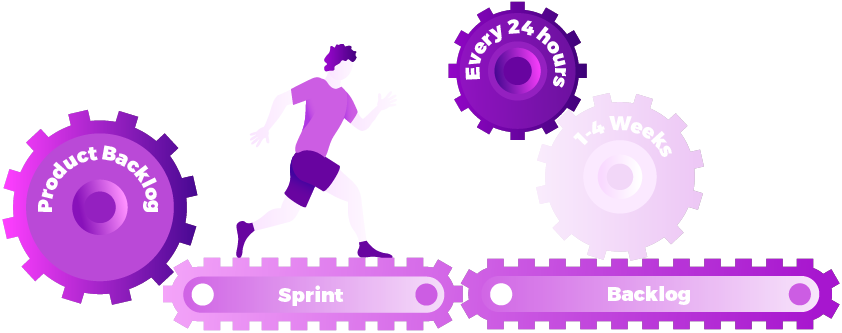
Instead of extensive planning and design up front, agile methodologies allow for changing requirements over time by using cross-functional teams – incorporating planners, designers, developers and testers – who work on successive iterations of the project over fixed time periods. The work is organized into a backlog that is prioritized into exact priority order based on business (or user) value.
Agile Advantages
- This approach allows for changes to be made after the initial planning phase.
- It’s easier to add features so you can stay up-to-date in your industry.
- Short feedback-loops ensure you’re not building something people won’t want.
- Because testing is conducted at the end of each sprint, bugs are fixed before the end of the project.
- Because agile projects are so well tested, the project can be launched at the end of any cycle, making it more likely to meet its launch date.
Agile Disadvantages
- If a poor PM is in charge, the project can become a series of many short sprints, leading to the project coming in late and over budget.
- At the beginning of a big project, it can be difficult to assess the effort and resources required up-front.
- Because the project doesn’t have a definitive plan, the final project can be very different from what was initially intended.
When should you use the agile methodology?
- When speed trumps quality.
- When clients want to change the scope of the project.
- When there’s no perfectly defined deliverable.
- When you have an adept team that is flexible and can think independently.
- When the project is for a rapidly changing industry.
Project Management Jobs
As mentioned at the beginning of this resource, project management jobs are in high demand with not enough skilled applicants to fill them. For qualified candidates, project management roles are available in almost every industry, allowing you to pursue a career in a field that interests you most.
Let’s take a look at how you can gain project management experience, the jobs available, and how getting certified can net you a higher salary.
Project Management Experience
Gaining relevant project management experience is crucial to working your way up the career ladder and going from entry and mid-level roles to senior and management positions.
You can gain project management experience in a number of ways, and you do not need to have the title of “project manager” to do so. Here are a few ways you can get some experience under your belt:
Participate as part of a project team at work
Project team members gain invaluable experience and exposure to all aspects of project management, from research to planning to completing deliverables. You may already be a project team member at your organization without the formal recognition. If not, ask if you can participate and attend project meetings relevant to your role to gain some experience.
Volunteer at a charity or NGO
Giving your time and expertise as part of a non-profit or community effort is a great way to build up your project management experience, especially if your current role at work doesn’t allow you this opportunity. Having this experience can not only teach you valuable project management lessons, but also looks attractive on your resume.
Create and run your own projects
If you can identify opportunities for improvement within your department or community groups, take the initiative to present the problem and ask to lead the project. You can start small by implementing an improvement to a process or coordinating an event. In addition to the experience you will gain, you are also demonstrating to your managers and superiors that you are interested in taking on more responsibility and advancing in the organization.
Project management experience phases
PMI outlines five process phases of project management experience: Initiation, Planning, Execution, Monitoring, and Controlling, and Closing. You may remember some of these phases from earlier when we covered the project management lifecycle.
If you are planning on getting certified, your experience will align to these phases. You may have more experience in one area than another, and that is completely normal.
The phases of project management experience can be broken down as follows:
Initiation
- Defining a project at its broadest level, usually with a business case
- Researching feasibility - is it worth undertaking? Does it need additional research?
- Getting the greenlight from key stakeholders
Planning
-
Developing a project roadmap
- Identifying the costs, quality, available resources, and a timetable
- Creating SMART goals
- Establishing baselines and measures
- Clearly defining roles and responsibilities
Execution
- Creating and completing project deliverables
- Assigning resources
- Procurement
- Status meetings
- Team development
- Tracking and measuring
- Modifying project plans as needed
Monitoring and Controlling
- Using the predefined KPIs to track the project’s success. If this is a marketing campaign, you might monitor the Click Through Rates (CTR) and the Cost Per Click (CPC).
- Measuring if the project remained within schedule and budget
- Quality checking the deliverables
Closing
- Recognizing valuable team members
- Learning from the successes and challenges the project brought
- Documenting and preparing a final report
Documentation is an important part of gaining project management experience. Not only does it let you reflect on your years of hard work and strategize for the future, it’s also vital if you intend on applying for a certification like CAPM® or PMP®. PMI audits a select percentage of test takers, which means that you will need to get signatures from project leaders certifying that you put the numbers of hours into the work you stated you did.
Project Management Salary
Some consider project management to be CEO training. Both roles require similar skills and face similar challenges, such as managing budgets and working closely with stakeholders.
And both roles can be quite lucrative. Let’s have a look at how project management salaries vary by industry, location, and certification.
Project management jobs by industry
According to PMI’s project management salary mean survey, the highest paid industries for project management in the US are:
- Engineering project management jobs – $124,4346
- Aerospace project management jobs – $129,732
- Natural resources project management jobs – $134,577
- Consulting project management jobs – $134,149
- Pharmaceutical project management jobs – $133,246
Note that the salaries vary from country to country. Stats are available for other countries here.
It’s important to note, though, that no matter the industry you work in, earning a certification shows employers that you have the skills and experience to be considered for management, leadership, and higher-paying positions.
Project management jobs by location
Countries where project management professionals report the highest median salaries are Switzerland ($130,996), the United States ($112,000), and Australia ($108,593). Salaries vary city by city, too, so it’s important to factor in the cost of living when deciding where to take up employment.
Project management jobs by certification
The same PMI survey found that certified PMP® holders earn an average salary of $119,235 compared to $99,070 for their uncertified counterparts – that’s almost a 20% increase. However, the average increase in salary can vary depending on the role, industry, and company.
Supply and demand also plays a role in your post-certification salary. PMI survey respondents in South Africa and Ecuador earn, respectively, a staggering 58% and 53% more once they are certified. Like other jobs, median salaries increase with tenure, too.
Now you know getting certified can significantly boost your pay packet, you might be wondering what you need to qualify for the most well-known credentials, like PMP or CAPM. Check out our guide to project management certification for an in-depth run down of everything you need to get certified.
Ready to learn more about project management and prepare to get certified?
GoSkills project management courses prepare you for industry gold-standard certifications like the PMP and CAPM credentials. As an Authorized Training Partner (ATP) with PMI, our courses can help you meet the certification requirements for project management education.
Browse GoSkills PMI accredited Project Management online courses today and kickstart your career.
View project management courses